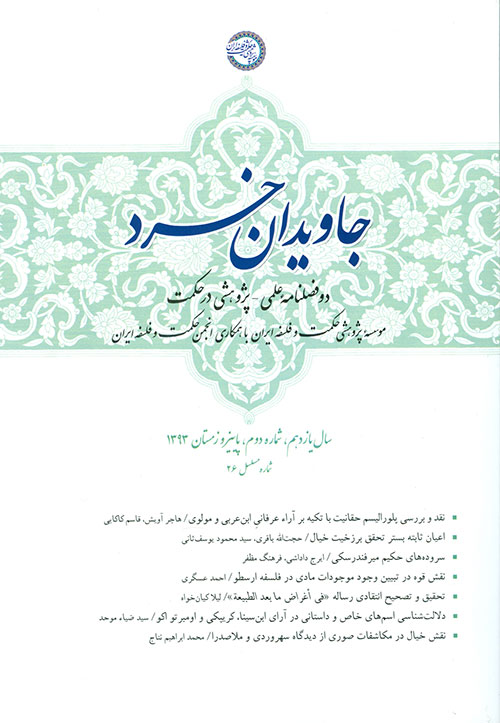
About the Journal
|
|
 |
|
|
Agnostics believe in stopping epistemological judgment about the existence of God. This epistemological-theological problem has various types; Based on the people included in this ruling, some consider this ruling to include all cognitive actors (strong) and some do not think so and do not consider different people to have a general ruling (weak). Therefore, weak agnosticism means that: the epistemological agent is allowed to remain without final judgment regarding the existence of God. Two main reasons can be put forward in defense of this attitude; (1) Considering the epistemological position and the variety of the conditions and abilities of the epistemological agents and the effect of this feature on the knowledge of the evidence and their weighting, their various judgments, including remaining agnostic about the existence of God, are justified. While accepting the difference in epistemic situations, this reason is acceptable as long as the person believes in the ethics of his knowledge and fulfills his epistemic duties. (2) based on a reading of the principle of epistemological conservatism (a person can continue to believe as long as he does not find a reason against his belief), the internal reasons of individuals are sufficient for the legitimacy of continuing their belief; As a result, a person who reaches atheism is justified in the principle and extension of this belief. Limiting this principle to internal reasons is problematic, so it cannot be considered as a support for weak agnosticism.
The wisdom of afzal-addin kāshāni has been studied by some scholars such as abbas zaryab khoyi and seyyed hossein nasr, and especially by william chittick. The first scholar has placed afzal-addin among isma'ili philosophers, while the second scholar thinks that he has been a sufi, as his title baba clearly shows. on the other hand, chittick in his book entitled the heart of Islamic philosophy argues that afzal can not be placed in categories such as isma' iliyyah or sufiyyah, but all that can be said about his wisdom is this: it is the wisdom of self- knowledge. In this essay we try to show that afzal has had a good knowledge of ishraqi wisdom of suhrawardi, and moreover he has translated in persian some passages of suhrawardi's at-talwihat. we can say that he has expressed in persian language the most complex ishraqi conceptions through the most clear sentences.
The image of philosophy and the philosopher in Farabi's works is similar to the use of divine wisdom and the Qur'an: is the legacy of the prophets' teachings, a divine gift, a factor in guidance and along with governance. The teachings of the sages are mysterious, philosophy is unified and can be combined with religion. A philosopher has the appearance of a prophet and should be adorned with theoretical virtues such as love for the truth and research on the way to it, and moral virtues such as truthfulness, piety, asceticism from material desires, and believe in religious beliefs such as the creation of the world by the creation of a single agent, resurrection, the observance of the rules of heavenly religions. Wisdom and Hakim in their true meaning are reserved for God. The course of discussions in the most important works of Farabi starts from the origin of existence.
The Chinese word Jing 經 denotes a type of book with the qualities that make it celestial and sacred. Etymologically, this word is at root related to the symbol of warp (in contrast to weft) and other symbols of weaving. Despite the frequent usage of this word in the title of many traditional writings in China, the symbolic aspects of this ideograph are commonly neglected. This paper, explaining the primary meanings of Jing considering its graphical etymology as an ideograph, tries to clear up the complex of many conceptions associated with this Chinese character. It further examines the symbolism of weaving while clarifying the relationship of the concept of sacred texts with many other meaning of Jing, This study that can be regarded as a kind of symbolic etymology, based upon the traditional method of word-symbol-meaning, represents some important dimensions of the conception of sacred texts for the Chinese.
در منطق جدید، گزارههای کلی را به گزارههای شرطی تحویل میبرند. در این مقاله نشان میدهم که ابنسینا نظراتی مشابه منطق جدید داشته است هرچند سخنان او به صورت دقیق با تحلیل منطقدانان جدید همخوانی ندارد. بیشتر عبارتهای ابنسینا به این دلالت دارد که گزارههای حملی و شرطی صرفا «همارز»اند اما در موارد نادری نیز عباراتی در آثار ابنسینا دیده میشود که گویا دلالت بر «اینهمانی» گزارههای حملی و شرطی دارد که البته حکمی است بسیار قویتر. در این مقاله، تلاش میکنم نظریات ابنسینا را گزارش و دستهبندی کنم و دوری و نزدیکی آنها را با تحلیل منطق جدید نشان دهم.
Iran’s exposure to Kantian ideas has been a relatively new process which dates back approximately to the late 19th and early 20th centuries. By drawing on a select range of primary and secondary source material, this paper will explore the reception of Kantian philosophy in Iran and more specifically, within the context of modern philosophical Persian, in three distinct but interrelated analytical domains, presented in three sections. The first section will provide a general introduction in the context of the late 19th century background which, although unsystematic, gradually set the stage for the initial exposure of several individual Iranian philosophers and scholars with interest in philosophy, to Kantian ideas, and it will do so within a broader canvas of modern continental philosophy. In this same context a measured use of Persian (as distinct from Arabic) in reporting on or summarizing modern European philosophical ideas and arguments will be considered. The second section will show that since its early stages of reception in Iran, Kant was viewed in almost two parallel intellectual trajectories—namely, Kantian ideas as such and in their own right, especially with regard to his elucidation of categories (both epistemic and evaluative) and, in relation to that, his embarking on a systematic approach to the analysis of faculties. And second, in terms of their fundamental contributions in articulating and laying the foundations of what was subsequently referred to as “critical philosophy” and their impact on philosophers after Kant. This section will also introduce several early attempts by a number of influential Persian authors in the 1930s onwards who represented this twofold reception. The third section will then discuss subsequent attempts at introducing, summarizing, and notably translating Kant that gradually appeared with more frequency, from the 1970s and 1980s onwards. In fact, it is from this period forward that we can see a more sustained level of efforts in delivering Kant to a gradually expanding Persian-speaking audience. Here questions over terminology, style, and diction (in the sense, syntax), have come to play a central role in contemporary Persian renditions of Kant. Finally, and within the limitations of time, the third section will address the question of language still further—not only in terms of the technical requirement of having a sufficient grasp of the language(s) of the original texts on the part of the translators (be it from the German original or from translations in other languages such as French, English, or Arabic), but also in terms of the translators having effective facility with the language of destination (i.e. Persian). However, the latter challenge in turn can often entail additional variables which are at the same time both external (or extrinsic) as well as being subjective, and hence particularly complex. The authorial interplay and the balancing act between accuracy and elegance can often be swayed by individual translators’ ideational (if not ideological) and semantic preferences which can readily either follow or defy standardization and uniformity in the overall project of translation, a topic which will be briefly examined in the paper’s closing section. In a broader sense it can perhaps be argued that the scope of this overview falls somewhere in the intersection of the history of ideas (moving slowly towards assuming a place in the intellectual history, but not quite yet), sociology of knowledge, and translation studies.
The Peripatetic conception of knowledge is based on essentialism. This strong realist conception of knowledge has faced serious criticisms. One of the most important criticisms of this view has been raised by Suhrawardi. According to Suhrawardi’s criticisms of Avicenna, human perception is primarily based on sensory encounters with the external world. Furthermore, one can never be certain that the entirety of an essence is comprehended by human perception. Therefore, it seems that despite the initial conception, accepting an essentialist epistemic realism does not suffice in explaining knowledge. This paper argues that the response to this challenge lies in understanding the nature of classical epistemology: classical epistemology seeks to outline an ideal of knowledge, always assessing actual human knowledge in relation to this ideal. Therefore, although the comprehension of the intelligible essences of objects is considered a difficult task, it remains an epistemic ideal for assessing the actual human knowledge.
In the narrative heritage of Imamiyah, there is a report of Imran Sabi's debate with Imam Reza (p.b.u.h), based on which Imam (p.b.u.h) gave a negative answer to Imran's question about God's self-awareness. In resolving the possible conflict between the rational principle and the narrative doctrine of the necessity of divine knowledge, Shia thinkers have considered the question of Imran to be related to a special type of self-awareness that requires limitations and defects for God. Based on the induction, at least five major explanations have been made regarding such an approach, that is, a kind of deprivation of self-awareness from God. These explanations have failed to provide the correct meaning of Imam's (p.b.u.h) statement. Of course, the lack of these explanations does not mean the negation of the main approach in dealing with the desired expression, but by maintaining this approach, it is possible to provide a correct explanation of the narration.

|
|
 |
|
|




Number of Volumes
17
Number of Issues
38
Submitted Articles
798
Rejected Articles
531
Accepted Articles
180
Rejection Rate
67
Acceptance Rate
23
Number of Authors
365
Number of Reviewers
120
Number of Indexing Databases
5
Article View
398,827
PDF Download
185.005
Views Per Article
1169.63
PDF Download per Article
542.5